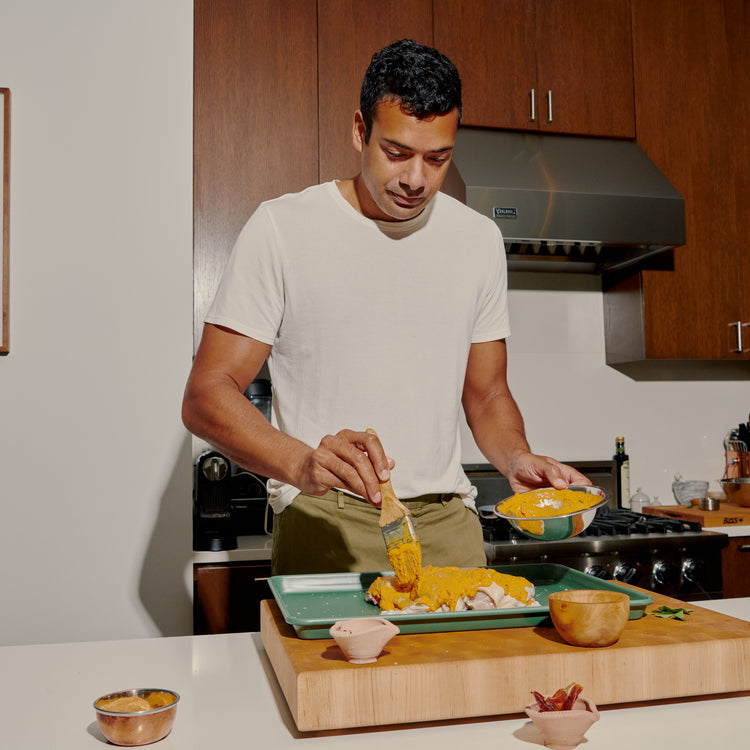Great Ones is a celebration of humans we admire — and an exploration of why they cook, not just how. Basu Ratnam is the founder of INDAY, an Indian-inspired fast-casual restaurant group in New York City. In response to the devastating impact of COVID-19 in India, Basu also started 1 Billion Breaths, a global movement to raise funds for relief efforts. We partnered with Basu and 1 Billion Breaths to donate a portion of sales from The Whole Grain Family — the first Great Jones design made in India — to local aid organizations. Here, we joined him in his home in New York City to make a spin on a tandoori rotisserie chicken, using Small Fry and Holy Sheet.
I grew up in an Indian-American household in Oyster bay, New York. The rhythm of our family was driven by my mom and being in the kitchen with her. She cooked our meals every single day and would make Indian food for my dad and more Americanized food for me and my sister. She also had a garden and was always trying to teach us about the ingredients and how to experiment with different flavors and cuisines.
The rhythm of our family was driven by my mom and being in the kitchen with her.
 We did a lot of big cooking projects together. One of my earliest memories is making biryani with her — I loved biryani growing up, and we would shop for ingredients and spices and try different biryani recipes until we found a regional style we liked. I started cooking more in college, and then started to really understand how to build flavors once I was in my early 20s, cooking for myself in New York City.
We did a lot of big cooking projects together. One of my earliest memories is making biryani with her — I loved biryani growing up, and we would shop for ingredients and spices and try different biryani recipes until we found a regional style we liked. I started cooking more in college, and then started to really understand how to build flavors once I was in my early 20s, cooking for myself in New York City.
Cooking for me is the closest thing that I experience to alchemy.

Cooking for me is the closest thing that I experience to alchemy — the idea that you can combine different ingredients and, depending on the heat and timing, create something that’s greater than the sum of its parts. That feels like a kind of magic. For me, it’s a way to ground myself after a long day, experiment and be creative, and support local businesses.
The whole thing is a part of my life that I really enjoy. It keeps me connected to my roots and also grounded in the present. My greatest joy is coming up with a menu, going around and shopping, seeing local vendors, trying to find the very best of a specific ingredient, and then marrying it all together.
Food can serve as nourishment and feed your mind, body, spirit, and community.
INDAY came to life when I was working in finance in New York City, buying and selling big clothing companies. I felt like the further I moved in my career, the further I moved from what I cared about. It was actually something that one of my former bosses pointed out to me. I had these lifelong memories of being around food, and my mom had really created this idea that food can serve as nourishment to feed your mind, body, spirit, and community. I felt like that was a really beautiful idea — and a noble one to pursue. INDAY came from that way of thinking about the world.

At the time I had not worked in a restaurant before and knew it would be challenging. I went to the smartest people in my life with a business plan and asked them to tell me all the reasons why I shouldn’t do it. I was 26 at the time, and I was so surprised by how encouraging they were — many of them offered to not only be my advisers but also my first investors. That was enough to push me to start.
I remember us outside on the street, celebrating with cheap champagne in plastic cups. That moment felt monumental.

That was seven years ago, and I remember that, in the earliest days, something I hadn’t appreciated was how hard it would be to get a lease signed. Even if you had a great idea, a good résumé, and financial backing, it was challenging to find a landlord of a multi-billion-dollar building that was going to take a chance on us. Maybe that was my privilege not to realize this. It took a year and a half to get that lease, and I remember us outside on the street, celebrating with champagne in plastic cups. That moment felt monumental.
In the early days, we were just figuring out what was up and what was down. We were so busy and opened with a line out the door. We thought we’d made enough food for 500 people and sold out in an hour. Turns out we had miscalculated our inventory and had only prepared enough for about 90 meals. It felt really busy, but we had no concept of what busy meant at the time — it was our first day in business.

We had lost chefs and friends, and so many people on my team had lost family members.
We started 1 Billion Breaths about a year into COVID. We had lost chefs and friends, and so many people on my team had lost family members. It was not that we did not experience a tremendous amount of loss, but fast-forward to April 2021, and things had started to stabilize. It felt like we could see the light at the end of the tunnel: Loved ones were getting vaccinated, and we were settling into a new normal. At the same time, while we were finding stability, there was this second wave in India.

There was really an opportunity to come together as Indian Americans and as a community of Indian restaurants from all over the world.
India was inadequately prepared for it to be an issue at the scale that it was. There was a period where you didn’t want to look at your phone because it was filled with messages and posts about the most horrifying situations. Every day there was a new death, and the numbers were catastrophic. The second wave hit hard in India around the same time that we, in New York, felt like we were just emerging from the lowest point.
There is a strong and connected Indian-American diaspora community here. It felt like, even though we were also still recovering, there was really an opportunity to come together as Indian Americans and as a community of Indian restaurants from all over the world. We held two events: One was a global meal campaign that raised about $400,000, and then another that brought in close to $350,000. We sent all of that money back to India to a variety of aid organizations that were focused on sustainable COVID care and relief.
I don’t often ask people for help, but in this instance, I felt such a compulsion to do as much as we could.

For us, everything was moving very quickly, and we didn’t have time to stop and think about what it meant. I felt a very significant and meaningful sense of a form of survivor’s guilt — it was an emotional reaction that I hadn’t felt before, except perhaps around 9/11. I don’t often ask people for help, but in this instance, I felt such a compulsion to do as much as we could, and it was great to see how many people came together. The part that particularly moved me, especially knowing how much restaurants had struggled during the past 12 months, was that 40 restaurants from around the world participated — from mom-and-pop shops in Canada to Peru and the Middle East.
It felt very necessary, and I’m very proud of the work.

It was not just me — it was a team effort with people who had day jobs and who worked overtime to do the vetting and coordination. It felt necessary, and I’m very proud of the work we did, knowing the impact of the funds raised.
I actually used a very special spice rub that came from the late Floyd Cardoz and his family.
Today, I made a tandoori rotisserie chicken from the INDAY menu, and it’s very much in line with the way I think about food. We use a traditional yogurt marinade, and it marinates for a couple of days. I actually used a very special spice rub that came from the late Floyd Cardoz and his family. Floyd and I had reconnected right before he passed away from COVID, so it’s a sentimental spice mixture for us.
That’s the base of the tandoori masala, and I used Small Fry to temper the whole spices before crushing them into the dish. The chicken I used is from a farm in Pennsylvania. It’s spatchcocked so it’s flat and roasts more evenly, which keeps it juicy. We cook it in a rotisserie oven, which is not traditional for tandoori, but it feels representative and combines a lot of different stories of seasonality, New American techniques, and flavors that remind me of home. At home, you can cook it in the oven, and we roasted it with fingerling potatoes that capture the juice and fat from the chicken.

It represents seasonality and flavors that remind me of home and great Indian chefs in my life.

Looking ahead, we are working on opening a new restaurant concept next spring. It explores the idea of Indian comfort food and what it means to be an Indian neighborhood restaurant. It’s going to be incredible.
"I love Holy Sheet — it’s my favorite sheet pan. First of all, it’s beautiful and elegant to use, and very easy to cook on. The color makes it part of the show — you can really serve your meal on it, which is usually not the case with a sheet-pan dish."























